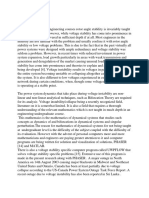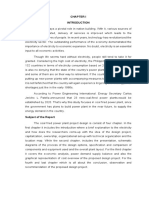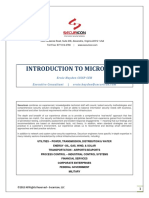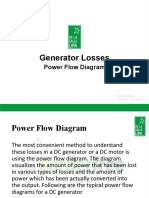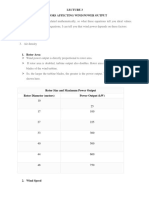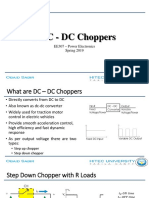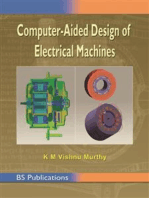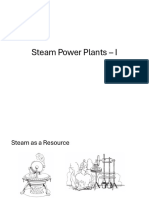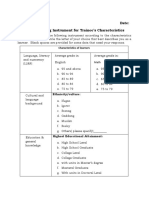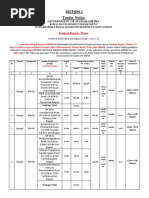0 ratings0% found this document useful (0 votes)
125 viewsSteam Power Station Design
Steam Power Station Design
Uploaded by
Rimsha KhursheedThe document outlines the key steps and considerations for designing a steam power station, including selecting a site, estimating capacity, choosing turbines and other equipment, and designing fuel handling, piping, and other core systems. It discusses characteristics like efficiency and environmental impact. Key factors in choosing equipment include capacity, fuel type, cost, reliability, and site constraints. The overall goal is a design that safely and efficiently converts fuel into electrical power.
Copyright:
© All Rights Reserved
Available Formats
Download as PPTX, PDF, TXT or read online from Scribd
Steam Power Station Design
Steam Power Station Design
Uploaded by
Rimsha Khursheed0 ratings0% found this document useful (0 votes)
125 views29 pagesThe document outlines the key steps and considerations for designing a steam power station, including selecting a site, estimating capacity, choosing turbines and other equipment, and designing fuel handling, piping, and other core systems. It discusses characteristics like efficiency and environmental impact. Key factors in choosing equipment include capacity, fuel type, cost, reliability, and site constraints. The overall goal is a design that safely and efficiently converts fuel into electrical power.
Original Description:
assignment
Original Title
3. Steam Power Station Design (1)
Copyright
© © All Rights Reserved
Available Formats
PPTX, PDF, TXT or read online from Scribd
Share this document
Did you find this document useful?
Is this content inappropriate?
The document outlines the key steps and considerations for designing a steam power station, including selecting a site, estimating capacity, choosing turbines and other equipment, and designing fuel handling, piping, and other core systems. It discusses characteristics like efficiency and environmental impact. Key factors in choosing equipment include capacity, fuel type, cost, reliability, and site constraints. The overall goal is a design that safely and efficiently converts fuel into electrical power.
Copyright:
© All Rights Reserved
Available Formats
Download as PPTX, PDF, TXT or read online from Scribd
Download as pptx, pdf, or txt
0 ratings0% found this document useful (0 votes)
125 views29 pagesSteam Power Station Design
Steam Power Station Design
Uploaded by
Rimsha KhursheedThe document outlines the key steps and considerations for designing a steam power station, including selecting a site, estimating capacity, choosing turbines and other equipment, and designing fuel handling, piping, and other core systems. It discusses characteristics like efficiency and environmental impact. Key factors in choosing equipment include capacity, fuel type, cost, reliability, and site constraints. The overall goal is a design that safely and efficiently converts fuel into electrical power.
Copyright:
© All Rights Reserved
Available Formats
Download as PPTX, PDF, TXT or read online from Scribd
Download as pptx, pdf, or txt
You are on page 1of 29
Steam Power Station Design
• A satisfactory design consists of following steps
• Selection of site
• Estimation of capacity of power station
• Selection of turbines and their auxiliaries
• Selection of boilers and their auxiliaries
• Design of fuel handling system
• Selection of condensers
• Desing of cooling system
• Design of piping system
• Selection of electrical generator
• Design and control of instruments
• Design of layout of power station
Characteristics of steam power plant
• Higher efficiency
• Lower cost
• Ability to burn coal
• Reduced environmental impact
• Reduced water requirement
• Higher reliability and availability
Selection of site
• Distance from coal mines
• Distance from load center
• Availability of water
• Ash disposal
• Distance from popular area
• The selected site should be capable of supporting a large building and
heavy machinery.
Coal handling
• Coal Delivery
• Ships or boats near shore
• Railways or trucks awary from shore
• Unloading
• No need if deliverd by truck, directly dumped
• By rotary car dumpers, cranes, grab buckets if delivered by railways, ships etc.
• Preparation
• Sizing by crushers, breakers, sizers
Cont’d
• Transfer
• Belt/screw/flight conveyors
• Bucket/grab bucket elevators
• Outdoor storage (dead storage)
• Covered storage (live storage – bins and bunkers)
• In plant handling (inside plant)
• Weighing and measuring (weigh lorries, hoppers and automatic
scales) methods are mechanical, electrical and pneumatic.
• Furnace – grate fired furnace; chamber fired furnace
Steam turbines
• Main parts of steam turbine are
• Rotor
• Bearing to support the shaft
• Metallic casing
• Governor to control the speed
• Lubricating oil system
Classification of steam turbine
• Depending upon the methods of using steam, arrangement and
construction of blades, nozzle and steam passages, the steam
turbines can be classified as follows: (name only)
• According to action of steam
• Impulse
• Reaction
• Impulse and reaction
• According to direction of steam flow
• Axial
• Radial
• mixed
Cont’d
• According to pressure of exhaust
• Condensing
• Non-condensing
• Bleeder
• According to pressure of entering steam
• Low pressure
• High pressure
• Mixed pressure
• According to step reductions
• Single stage
• Multi-stage
Cont’d
• According to method of drive
• Direct connected
• Geared
• Choice of steam turbine
• Capacity of plant
• Plant load factor and capacity factor
• Thermal efficiency
• Reliability
• Location of plant with reference to availability of water for condensate
Boiler & Feed water treatment
• A closed vessel in which water is converted into steam by the
application of heat.
• A boiler should fulfil the following requirements:
• Safety
• Accessibility
• Capacity
• Efficiency
• Simple in construction
• Low initial and maintenance cost
• The boiler should have no joints exposed to flames.
• The boiler should be capable of quick starting and loading.
Cont’d
• Types of boilers (name only)
• According to flow of water and hot gases
• Water tube—Babcock and Wilcox; La Mont Boilers
• Fire tube– Cornish; Locomotive; Cochran
• According to position of furnace
• Internally fired
• Externally fired
• According to position of principle axis
• Vertical
• Horizontal
• inclined
Cont’d
• According to application
• Stationary
• Mobile (marine, locomotive)
• According to circulating water
• Natural circulation
• Forced circulation
• According to steam pressure
• Low
• Medium
• High
Cont’d
• Selection of boiler depends upon following factors
• Type of fuel
• Space available
• Cost of fuel
• Controls necessary to enable the load to be picked up quickly
• Desireability of using heat recovery equipment
• Type of load to be supplied by the boiler
Cont’d
• Boiler mountings and accessories
• Mountings are components used for safety of boiler. The boiler
requires following mountings:
• A feed check valve to prevent the return of water from boiler in base the feed
pump is not operating
• A steam stop valve to regulate the flow of steam from the boiler
• Safety valve (at least two) to protect the boiler from pressures higher than the
designed valve.
• A blow off valve to empty the boiler when needed and to discharge the mud
and sediments that collect in the boiler
Cont’d
• Water level indicators to show the water level inside the boiler
• A pressure guage to indicate the pressure of steam in the boiler
• Fusible plugs to protect the boiler against low water level.
• Boiler accessories
• Feed pumps to supply water in the boiler
• Economisers to heat the feed water before it enters the boiler
• Air pre-heaters to heat the air before it enters the furnace
• Super heaters to heat the steam above saturation temperature
• Draft equipment to supply air to furnace.
Generator
• A generator converts mechanical shaft energy it receive from the
turbine into electrical energy.
• Normally AC synchronous generators (alternators) of two or four pole
are used.
• Generating losses appearing as heat must be constantly removed to
avoild damaging the windings.
• Large generators have cylindrical rotors with minimum heat
dissipation surface and so they have forced ventilation to remove the
heat.
Cont’d
• Large generators generally use an enclosed system with air or
hydrogen coolant. The gas picks up the heat from the generator and
gives it up to the circulating water in the heat exchanger.
Steam condenser
• A steam condenser is meant to receive the exhaust steam from the
turbine, condense it and maintain a pressure at the exhaust lower
than atmospheric.
• Air inside the condenser should be pumped out continuously in order
to maintain the vacuum.
• Steam pressure in the condenser mainly depends on flow rate and
temperature of cooling water and on the effectiveness of air removal
equipment.
Cont’d
• Main advantages include increased output power.
• It recovers most of the feed water.
• Use of condenser reduces size of boiler installation.
• Types of condenser (name only)
• Surface condensers – down flow type; central flow; evaporation
• Jet condensers– low level (parallel flow); high level (barometric condenser);
ejector condener
Cont’d
• Selection of condenser
• Floor space (less for jet)
• Capital and maintenance cost (less for jet)
• In surface condenser, condensate is distilled water whereas in jet condenser,
it is mixed with cooling water and therefore cannot be used for boiler feed
water.
• Surface condensers are commonly used.
Piping system
• The piping system should fulfil the following requirements
• Piping system should be of necessary size to carry the required flow of fluids.
• Pipes carrying the fluids at high temperature should be able to withstand the
temperature and expansion caused due to the temperature changes.
• Piping system must withstand the pressure to which it is subjected.
• For smooth and safe operation and for easy inspection and maintenance it is
desireable to use minimu length of pipes consistent with the requirements
of the power station. Aslo a pipe should be run as direct and straight as
possible. The number of fitting and bends required to make the necessary
connections should be kept at a minimum to avoid pressure drop.
Cont’d
• Material for pipes
• Cast iron
• Wrought iron
• Wrought steel
• Alloys steel
• Copper and brass
Overall Thermal Efficiency
• The overall thermal efficiency depends upon the efficiency of boiler,
turbine and alternator.
H = heat equivalent per kWh (1kWh = 860 kcal)
W = amount of coal consumped per kWh
CV = calorific value of coal
Example 1
• The overall thermal efficiency of a 40MW turboalternator is 30%. If
the load factor is 50% and coal burnt has calorific value of 6800 kcal,
determine the following
• (i) coal consumption per kWh
• (ii) coal consumption per day
Solution
• Load factor = average load/maximum demand
• Assume maximum demand is equal to capacity of power station i.e.
40 MW
• Average load = 0.5 * 40 * 1000 = 20,000 kW
• Energy produced per day = average day * 24
= 20,000 kW * 24
= 480 MW
Cont’d
• Overall thermal efficiency = 860/W * 6800
1kWh = 860 kcal
• W = 860/0.3 * 6800
= 0.42 kg
Coal required per day = energy produced * W
= 48 MW * 0.42
= 201,000 kg (1000kg = 1 ton)
= 201 tonnes
You might also like
- VDA Special CharacteristicsDocument45 pagesVDA Special Characteristicsrenato fabbri100% (13)
- Laser Fiber Cutting Machine-F Series User ManualDocument78 pagesLaser Fiber Cutting Machine-F Series User Manualsundar50% (8)
- Method Statement of Fire Alarm SystemDocument10 pagesMethod Statement of Fire Alarm Systemmidhun murali100% (7)
- Mechanical Er. A. Suresh ResumeDocument4 pagesMechanical Er. A. Suresh ResumeGovindarajan ChandraNo ratings yet
- Voltage Instability ReportDocument24 pagesVoltage Instability ReportPravat Satpathy100% (1)
- EE406-2018 Practice QuestionsDocument1 pageEE406-2018 Practice QuestionsDevashishNo ratings yet
- Game Engines Assignment 1Document6 pagesGame Engines Assignment 1api-314623232No ratings yet
- Emerging Trends in Thermal Power Stations: K Sreerama MurthyDocument22 pagesEmerging Trends in Thermal Power Stations: K Sreerama Murthywaleedalzaidi100% (1)
- 1000 MWDocument87 pages1000 MWJohn Paul Coñge Ramos100% (1)
- Kangan ReportDocument26 pagesKangan ReportHybrid Power systemNo ratings yet
- Fed Budget 2024 25 CFTH SubmissionDocument10 pagesFed Budget 2024 25 CFTH SubmissionsarahNo ratings yet
- Thermal Plant Ropar 1260MWDocument89 pagesThermal Plant Ropar 1260MWRahul Pandey71% (7)
- Introduction To Microgrids - Securicon - 2013 - 1Document13 pagesIntroduction To Microgrids - Securicon - 2013 - 1Wyatt HurleyNo ratings yet
- Comparison of Control System Using PLC & PIDDocument6 pagesComparison of Control System Using PLC & PIDhamidouhouNo ratings yet
- Hinduja National Power Corporation LIMITED (Hinduja Power Plant)Document2 pagesHinduja National Power Corporation LIMITED (Hinduja Power Plant)Anurag AllaNo ratings yet
- Plasma Supported Combustion: By, Prof DR ING M Hery Purwanto MSCDocument13 pagesPlasma Supported Combustion: By, Prof DR ING M Hery Purwanto MSCHery Purwanto100% (1)
- Variable Speed Drive For Converter Fed Synchronous Machine - PCS 8000 Variable-Speed Converter - (Converters For Pumped Storage Plants - ) - ABBDocument3 pagesVariable Speed Drive For Converter Fed Synchronous Machine - PCS 8000 Variable-Speed Converter - (Converters For Pumped Storage Plants - ) - ABBDeepak GehlotNo ratings yet
- Assignment - I 26 04 2020Document2 pagesAssignment - I 26 04 2020JackNo ratings yet
- Training ReportDocument42 pagesTraining ReportNaziya KosarNo ratings yet
- Internship Report FOR AP GENCODocument65 pagesInternship Report FOR AP GENCORajesh KalyanamNo ratings yet
- Load Curve and Load Duration CurveDocument4 pagesLoad Curve and Load Duration CurveKarmugilan Mugilan100% (1)
- Generator Losses: Power Flow DiagramDocument10 pagesGenerator Losses: Power Flow DiagramTrisha SARMIENTONo ratings yet
- Resume - 2010 - Power EngineerDocument2 pagesResume - 2010 - Power EngineerMilton CooperNo ratings yet
- Roadmap For Advanced Distribution Management System (ADMS) in The Integrated GridDocument3 pagesRoadmap For Advanced Distribution Management System (ADMS) in The Integrated Gridrasim_m1146100% (1)
- Refrigerant Based Cooling BatteriesDocument12 pagesRefrigerant Based Cooling Batteriesrosca raul100% (1)
- 132 KV Gss Mahaveer Nagar KotaDocument30 pages132 KV Gss Mahaveer Nagar KotaNaziya KosarNo ratings yet
- FulltextThesis 2Document209 pagesFulltextThesis 2Kean PagnaNo ratings yet
- Final PPT For BhelDocument16 pagesFinal PPT For BhelChandni Sharma50% (2)
- Lecture 3Document14 pagesLecture 3Benedicto MugongoNo ratings yet
- Voltage Source Converter Based HVDC: Transmission and DistributionDocument4 pagesVoltage Source Converter Based HVDC: Transmission and DistributionAshok kumar RNo ratings yet
- Solar Power PlantDocument69 pagesSolar Power PlantMark Anthony Lluvido PlatinoNo ratings yet
- Final Test - IEC-61730 - 2Document36 pagesFinal Test - IEC-61730 - 2Ronarong Kitirak100% (1)
- AP GencoDocument23 pagesAP GencoBhanu PrakashNo ratings yet
- Ready Reckoner Work Book-1: BEE-Exam Guide Book-1Document25 pagesReady Reckoner Work Book-1: BEE-Exam Guide Book-1udhayNo ratings yet
- 2.final Energy EfficiencyDocument29 pages2.final Energy EfficiencyVandana Vanu100% (2)
- Training Report of Ushp-II, Saqib MaqboolDocument28 pagesTraining Report of Ushp-II, Saqib MaqboolSaqib WaniNo ratings yet
- Modeling and Simulation of Wind Solar Hybrid System Using Matlab/SimulinkDocument7 pagesModeling and Simulation of Wind Solar Hybrid System Using Matlab/SimulinkAngelo Aco MendozaNo ratings yet
- ST2715Document20 pagesST2715mamz4uNo ratings yet
- Dual ConverterDocument11 pagesDual ConverterRoshan GokheNo ratings yet
- UTRF IS 16242 1 ReportDocument70 pagesUTRF IS 16242 1 ReportCragsmanNo ratings yet
- Machines Lab ManualDocument124 pagesMachines Lab ManualpurushothNo ratings yet
- VFD SDocument25 pagesVFD Svasanth11kvNo ratings yet
- Questions 1Document11 pagesQuestions 1anvithaNo ratings yet
- Traction Assembly ShopDocument3 pagesTraction Assembly ShopAshutosh Kumar Chaturvedi100% (1)
- The Hydraulic Machinery of Obervermuntwerk IIDocument8 pagesThe Hydraulic Machinery of Obervermuntwerk IIPeter MeusburgerNo ratings yet
- SSD Unit 1Document24 pagesSSD Unit 1Shashank SinghNo ratings yet
- Introduction To Electrical Power Systems: by K.rajendraDocument101 pagesIntroduction To Electrical Power Systems: by K.rajendrak rajendraNo ratings yet
- Design-of-Synchronous-Generator (Axial Length To Pole Pitch Ratio)Document3 pagesDesign-of-Synchronous-Generator (Axial Length To Pole Pitch Ratio)kyaw winNo ratings yet
- P3T32 en M J006 ANSI Web PDFDocument426 pagesP3T32 en M J006 ANSI Web PDFBruce NationNo ratings yet
- Heating and Cooling of Electric MachineDocument36 pagesHeating and Cooling of Electric Machinexettrinirmal2No ratings yet
- Current Transformer: Profile No.: 273 NIC Code: 27102Document14 pagesCurrent Transformer: Profile No.: 273 NIC Code: 27102Rama SubrahmanyamNo ratings yet
- Summer Training Report NTPC Badarpur 1Document35 pagesSummer Training Report NTPC Badarpur 1Vaishak NairNo ratings yet
- Design and Simulation of A Single Phase Front End ConverterDocument4 pagesDesign and Simulation of A Single Phase Front End Converterutsav.gonawalaNo ratings yet
- Project Report On Speed Control of DC Motor by Using PWM Technique 4Document76 pagesProject Report On Speed Control of DC Motor by Using PWM Technique 4Vishal SharmaNo ratings yet
- Distributed Generation With ATP EMTP PDFDocument6 pagesDistributed Generation With ATP EMTP PDFCarlos Lino Rojas AgüeroNo ratings yet
- Ebook MEDI2022 SpringerDocument273 pagesEbook MEDI2022 SpringerVidan FathiNo ratings yet
- DC-DC ChoppersDocument24 pagesDC-DC ChoppersAbdullah NasirNo ratings yet
- 1 - Power Generation, Transmission and DistributionDocument41 pages1 - Power Generation, Transmission and Distributionamal_postNo ratings yet
- Modeling of Photovoltaic Systems Using MATLAB: Simplified Green CodesFrom EverandModeling of Photovoltaic Systems Using MATLAB: Simplified Green CodesNo ratings yet
- Steam Power Plants - IDocument22 pagesSteam Power Plants - IMuhammad Umar MunirNo ratings yet
- Unit I COAL BASED THERMAL POWER PLANTS PDFDocument80 pagesUnit I COAL BASED THERMAL POWER PLANTS PDFPrashant BornareNo ratings yet
- Unit 1Document80 pagesUnit 1LAXMI S FXEET036No ratings yet
- Presentation On Thermal Power Station: Presented ByDocument24 pagesPresentation On Thermal Power Station: Presented Bykritika negiNo ratings yet
- Automated Rain Wiper System For AutomobilesDocument4 pagesAutomated Rain Wiper System For AutomobilesManuNo ratings yet
- ADPCM ImplementationDocument13 pagesADPCM ImplementationDumitru GheorgheNo ratings yet
- ACTIVIDAD DE APRENDIZAJE NÚMERO 1 (Autoguardado)Document5 pagesACTIVIDAD DE APRENDIZAJE NÚMERO 1 (Autoguardado)Maria Fernanda Coronado bayonaNo ratings yet
- Safety Rules in ConstructionDocument4 pagesSafety Rules in ConstructionMariya MariyaNo ratings yet
- Fiab AlteraDocument42 pagesFiab AlteraRenéNo ratings yet
- Acars SDRDocument31 pagesAcars SDRcmuzziniNo ratings yet
- Shotmax ControlDocument12 pagesShotmax ControlAhmed Mohamed Abd ElsalamNo ratings yet
- Pre Assessment ToolsDocument12 pagesPre Assessment ToolsAlcantara CastilloNo ratings yet
- Section 1: Tender NoticeDocument3 pagesSection 1: Tender NoticedilipomiNo ratings yet
- The T Programming Language: A Dialect of LispDocument1 pageThe T Programming Language: A Dialect of LispPep DizNo ratings yet
- 01 5 Design and FunctionDocument19 pages01 5 Design and FunctionExtra EmailNo ratings yet
- Xlri 2023Document33 pagesXlri 2023Systemic ElectricNo ratings yet
- Network Secure Datasheet Ds P NSF 3100a I 20230904Document5 pagesNetwork Secure Datasheet Ds P NSF 3100a I 20230904ibrahim.gr4No ratings yet
- Harmonics and Mitigation Techniques Through Advanced Control in Grid-Connected Renewable Energy Sources: A ReviewDocument13 pagesHarmonics and Mitigation Techniques Through Advanced Control in Grid-Connected Renewable Energy Sources: A ReviewYeldo PailoNo ratings yet
- ERP Tata MotorsDocument14 pagesERP Tata MotorsSunny SinghNo ratings yet
- Datasheet It8718fDocument189 pagesDatasheet It8718fEduardo Montenegro100% (1)
- Rekofa - Slip Rings GM 2016Document1 pageRekofa - Slip Rings GM 2016Bruno MoraisNo ratings yet
- Ai̇rlogi̇c2 Qui̇ncy enDocument99 pagesAi̇rlogi̇c2 Qui̇ncy enNihat RustamliNo ratings yet
- 9 RA MIRI SamplingDSDocument66 pages9 RA MIRI SamplingDSSailaja SrinivasanNo ratings yet
- Air Data/Inertial Reference System (Adirs) - Description and OperationDocument2 pagesAir Data/Inertial Reference System (Adirs) - Description and Operationjontis jasoliyaNo ratings yet
- Automated Guided Vehicle System IJERTCONV6IS14074Document4 pagesAutomated Guided Vehicle System IJERTCONV6IS14074Ayush KesriNo ratings yet
- MicroSCADA X - Security GuideDocument116 pagesMicroSCADA X - Security GuideHai Pham MinhNo ratings yet
- A Study On Effects of Different Control Period of Neural Network Based Reference Modified PID Control For DC-DC ConvertersDocument6 pagesA Study On Effects of Different Control Period of Neural Network Based Reference Modified PID Control For DC-DC ConvertersAnkita AroraNo ratings yet
- Experiment 1.3: R-L Circuit Analysis and Power Factor DeterminationDocument5 pagesExperiment 1.3: R-L Circuit Analysis and Power Factor DeterminationDemoin GamingNo ratings yet
- SAP Transaction ListDocument34 pagesSAP Transaction ListBatheiah BolisettiNo ratings yet
- Semi-Active Force Generators FOR Shock IsolationDocument12 pagesSemi-Active Force Generators FOR Shock IsolationAres ZhaoNo ratings yet




